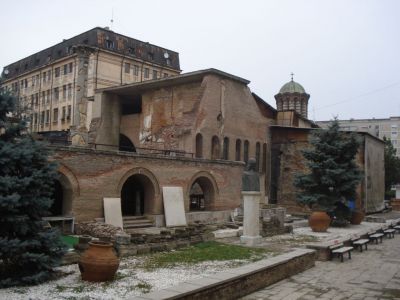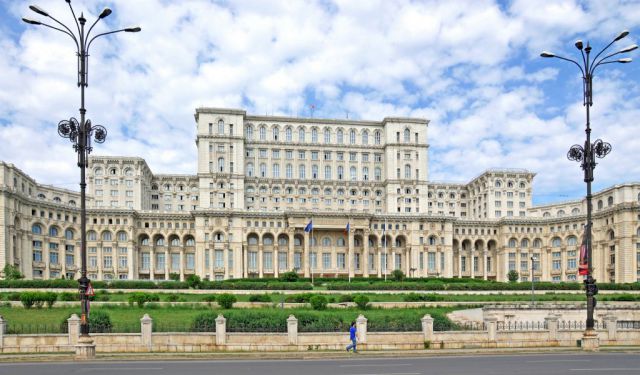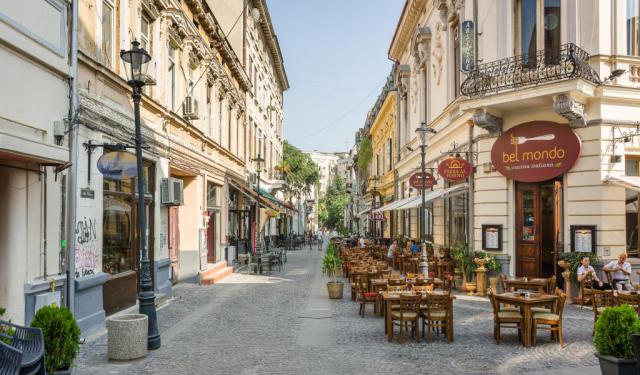
Curtea Veche (Old Court), Bucharest
Curtea Veche (the Old Princely Court) is a former royal residence in the historic center of Bucharest, built during the rule of Vlad III Dracula in 1459; currently operating as a museum.
Vlad the Impaler's reign was dominated by conflicts with the Ottoman Empire; hence the need to protect the southern border made him stay in the fortified town on the Dâmbovița banks. On 20 September 1459, he issued a document, specifically referring to the "fortress" in Bucharest, as his "princely residence".
In the 16th century, Mircea Ciobanul thoroughly rebuilt the palace, subsequently defining the limits of the city, with his court being its economic nucleus, surrounded by houses of traders and craftsmen, later known as the Lipscani. The princely church built by Mircea Ciobanul in 1559 is the oldest religious building maintained in its original role in Bucharest.
Matei Basarab repaired the palace during his own reign, and, after him, Constantin Brâncoveanu further extended it, adding stone columns and a marble staircase at the entrance. Fires, earthquakes and raids in the following years forced another ruler, Alexander Ypsilanti, to build a new princely court at Dealul Spirii, in 1775, upon which the old court acquired its present name.
In 1798, Ypsilanti's successor Constantin Hangerli sold the property for housing construction, at which point the history of the fortress ends. In 1800, Hanul lui Manuc, among other buildings, was built on the territory.
Archaeological excavations carried out throughout 1967-1972 discovered on the site remains of the royal palace, upon which it was turned into an open-air monument, which is now operated by the Muzeul Municipiului București. In its current role as a museum, the palace and the neighborhood inspired Mateiu Caragiale to write his novel, Craii de Curtea-Veche (Kings of The Old Court).
Vlad the Impaler's reign was dominated by conflicts with the Ottoman Empire; hence the need to protect the southern border made him stay in the fortified town on the Dâmbovița banks. On 20 September 1459, he issued a document, specifically referring to the "fortress" in Bucharest, as his "princely residence".
In the 16th century, Mircea Ciobanul thoroughly rebuilt the palace, subsequently defining the limits of the city, with his court being its economic nucleus, surrounded by houses of traders and craftsmen, later known as the Lipscani. The princely church built by Mircea Ciobanul in 1559 is the oldest religious building maintained in its original role in Bucharest.
Matei Basarab repaired the palace during his own reign, and, after him, Constantin Brâncoveanu further extended it, adding stone columns and a marble staircase at the entrance. Fires, earthquakes and raids in the following years forced another ruler, Alexander Ypsilanti, to build a new princely court at Dealul Spirii, in 1775, upon which the old court acquired its present name.
In 1798, Ypsilanti's successor Constantin Hangerli sold the property for housing construction, at which point the history of the fortress ends. In 1800, Hanul lui Manuc, among other buildings, was built on the territory.
Archaeological excavations carried out throughout 1967-1972 discovered on the site remains of the royal palace, upon which it was turned into an open-air monument, which is now operated by the Muzeul Municipiului București. In its current role as a museum, the palace and the neighborhood inspired Mateiu Caragiale to write his novel, Craii de Curtea-Veche (Kings of The Old Court).
Sight description based on Wikipedia.
Want to visit this sight? Check out these Self-Guided Walking Tours in Bucharest. Alternatively, you can download the mobile app "GPSmyCity: Walks in 1K+ Cities" from Apple App Store or Google Play Store. The app turns your mobile device to a personal tour guide and it works offline, so no data plan is needed when traveling abroad.
Curtea Veche (Old Court) on Map
Sight Name: Curtea Veche (Old Court)
Sight Location: Bucharest, Romania (See walking tours in Bucharest)
Sight Type: Museum/Gallery
Guide(s) Containing This Sight:
Sight Location: Bucharest, Romania (See walking tours in Bucharest)
Sight Type: Museum/Gallery
Guide(s) Containing This Sight:
Walking Tours in Bucharest, Romania
Create Your Own Walk in Bucharest
Creating your own self-guided walk in Bucharest is easy and fun. Choose the city attractions that you want to see and a walk route map will be created just for you. You can even set your hotel as the start point of the walk.
Bucharest Introduction Walking Tour
Bucharest, the capital and cultural center of Romania, is one of the largest cities in Southeastern Europe.
The name București has an unverified origin. Tradition links it to the guy named Bucur, who (according to various legends) was either a prince, outlaw, fisherman, shepherd or a hunter. The Romanian word “bucurie” means joy (happiness), which in turn explains one of Bucharest's... view more
Tour Duration: 2 Hour(s)
Travel Distance: 3.7 Km or 2.3 Miles
The name București has an unverified origin. Tradition links it to the guy named Bucur, who (according to various legends) was either a prince, outlaw, fisherman, shepherd or a hunter. The Romanian word “bucurie” means joy (happiness), which in turn explains one of Bucharest's... view more
Tour Duration: 2 Hour(s)
Travel Distance: 3.7 Km or 2.3 Miles
Old Town Walking Tour
The Historical Center of Bucharest, or the Old Town, as the locals habitually refer to it, is one of the most beloved and attractive areas in the Romanian capital. The neighborhood is really beautiful a place to visit, and you can walk into it pretty much from anywhere in central Bucharest. Ion Constantin Brătianu Boulevard crosses the historic heart of the city from Piata Universitate... view more
Tour Duration: 2 Hour(s)
Travel Distance: 1.9 Km or 1.2 Miles
Tour Duration: 2 Hour(s)
Travel Distance: 1.9 Km or 1.2 Miles
Useful Travel Guides for Planning Your Trip
16 Uniquely Romanian Things To Buy in Bucharest
Nicknamed "Little Paris", today's Bucharest is the capital of a vibrant European nation, known as Romania, with lots of history and great cultural heritage - spanning from centuries-old rural traditions to New Wave cinema. Keen on rustic stuff, Romanians carefully preserve their...



